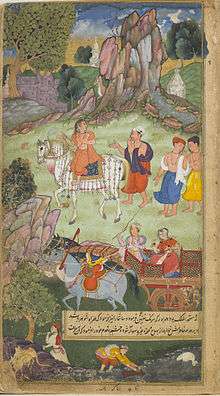Shanta
Shanta is a character in the Ramayana. She was the daughter of king Dasharatha and his elder consort Kaushalya. Later she was adopted by king Romapada of Anga Pradesh.
| Shanta | |
|---|---|
 Rishyasringa travels to Ayodhya with Shanta | |
| Affiliation | Daughter of Kaushalya |
| Personal information | |
| Parents | Dasharatha (father) Kaushalya (mother) Romapada (adoptive father) Vershini (adoptive mother) Sumitra (step-mother) Kaikeyi (step-mother) |
| Siblings | Rama (brother) Lakshmana (half-brother) Bharata (half-brother) Shatrughna (half-brother) |
| Spouse | Rishyasringa |
Shanta was married to Rishyasringa, son of the legendary Indian Hindu sage Vibhandaka.[1][2]
Life
Shanta was educated in the Vedas, arts, craft as well as in warfare, and was considered to have been very beautiful. One day, while her father, the king Romapada, was busy in conversation with Shanta, a brahmin came to ask for help in cultivation in the days of the monsoon. Romapada did not pay attention to the brahmin's plight. This irritated and enraged the brahmin, who left the kingdom. Indra, the god of rain, was unable to bear the insult to his devotee, so there was little rainfall during the monsoon season resulting drought in kingdom. Meanwhile, Dasharatha wanted a son to continue his legacy and to enrich his royal dynasty. It was advised that the troubles of both kingdoms could only be alleviated by yajnas performed by a brahmin with powers that come from observance of perfect chastity and that the only such person was Rishyasringa.[2]
Rishyasringa had been raised by Vibhandak Rishi, isolated from society without knowledge of women. He had to be brought to the city and be persuaded to carry out the necessary yajna ceremonies. Despite their fear of the power and anger of Vibhandak Rishi, both kings send young women to introduce the boy to the normal society, then Shanta fulfils this task and Rishyasringa marries Shanta, he then agrees to perform yajna for Anga, during the recitation of it, it rained heavily, the public rejoiced and there were festivals in Anga.[2]
Rishyasringa also performed a Putra Kameshthi yajna for Dasharatha to beget progeny, and as the consequence of the said Yajna were born: Rama, Bharata, and the twins Lakshmana and Shatrughna.There is a temple at Kigga, a small town near Shringeri, Karnataka, where idols of Shringa Rishi and Goddess Shanta are hosted. Shanta is said to have nursed Dasharatha during his death bed.[3]
References
- Rao, Desiraju Hanumanta. "Bala Kanda in Prose, Sarga 11". Valmiki Ramayana. Valmiki Ramayan.net. Retrieved 22 January 2019.
- Kanuga, G.B. (1993). The Immortal Love of Rama. New Delhi: Yuganter Press. pp. 48–49.
- "Sage-rishyashringa". sringeri.net.in. Retrieved 8 August 2020.
.jpg)
